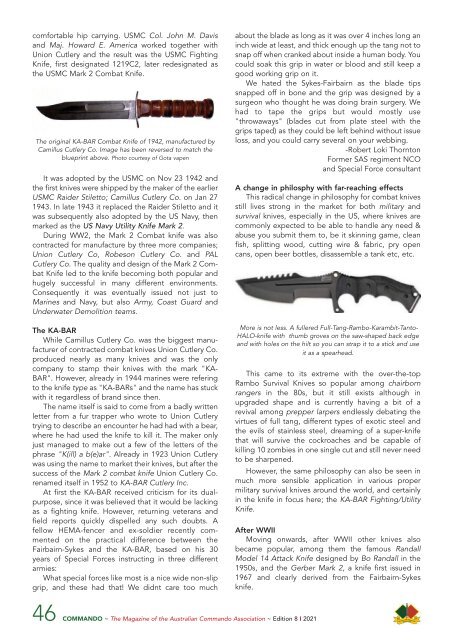Commando News Magazine edition 8 2021
You also want an ePaper? Increase the reach of your titles
YUMPU automatically turns print PDFs into web optimized ePapers that Google loves.
comfortable hip carrying. USMC Col. John M. Davis<br />
and Maj. Howard E. America worked together with<br />
Union Cutlery and the result was the USMC Fighting<br />
Knife, first designated 1219C2, later redesignated as<br />
the USMC Mark 2 Combat Knife.<br />
The original KA-BAR Combat Knife of 1942, manufactured by<br />
Camillus Cutlery Co. Image has been reversed to match the<br />
blueprint above. Photo courtesy of Gota vapen<br />
It was adopted by the USMC on Nov 23 1942 and<br />
the first knives were shipped by the maker of the earlier<br />
USMC Raider Stiletto; Camillus Cutlery Co. on Jan 27<br />
1943. In late 1943 it replaced the Raider Stiletto and it<br />
was subsequently also adopted by the US Navy, then<br />
marked as the US Navy Utility Knife Mark 2.<br />
During WW2, the Mark 2 Combat knife was also<br />
contracted for manufacture by three more companies;<br />
Union Cutlery Co, Robeson Cutlery Co. and PAL<br />
Cutlery Co. The quality and design of the Mark 2 Com -<br />
bat Knife led to the knife becoming both popular and<br />
hugely successful in many different environments.<br />
Consequently it was eventually issued not just to<br />
Marines and Navy, but also Army, Coast Guard and<br />
Underwater Demolition teams.<br />
The KA-BAR<br />
While Camillus Cutlery Co. was the biggest manu -<br />
facturer of contracted combat knives Union Cutlery Co.<br />
produced nearly as many knives and was the only<br />
company to stamp their knives with the mark "KA-<br />
BAR". However, already in 1944 marines were refering<br />
to the knife type as "KA-BARs" and the name has stuck<br />
with it regardless of brand since then.<br />
The name itself is said to come from a badly written<br />
letter from a fur trapper who wrote to Union Cutlery<br />
trying to describe an encounter he had had with a bear,<br />
where he had used the knife to kill it. The maker only<br />
just managed to make out a few of the letters of the<br />
phrase "K(ill) a b(e)ar". Already in 1923 Union Cutlery<br />
was using the name to market their knives, but after the<br />
success of the Mark 2 combat knife Union Cutlery Co.<br />
renamed itself in 1952 to KA-BAR Cutlery Inc.<br />
At first the KA-BAR received criticism for its dualpurpose,<br />
since it was believed that it would be lacking<br />
as a fighting knife. However, returning veterans and<br />
field reports quickly dispelled any such doubts. A<br />
fellow HEMA-fencer and ex-soldier recently com -<br />
mented on the practical difference between the<br />
Fairbairn-Sykes and the KA-BAR, based on his 30<br />
years of Special Forces instructing in three different<br />
armies:<br />
What special forces like most is a nice wide non-slip<br />
grip, and these had that! We didnt care too much<br />
about the blade as long as it was over 4 inches long an<br />
inch wide at least, and thick enough up the tang not to<br />
snap off when cranked about inside a human body. You<br />
could soak this grip in water or blood and still keep a<br />
good working grip on it.<br />
We hated the Sykes-Fairbairn as the blade tips<br />
snapped off in bone and the grip was designed by a<br />
surgeon who thought he was doing brain surgery. We<br />
had to tape the grips but would mostly use<br />
"throwaways" (blades cut from plate steel with the<br />
grips taped) as they could be left behind without issue<br />
loss, and you could carry several on your webbing.<br />
-Robert Loki Thornton<br />
Former SAS regiment NCO<br />
and Special Force consultant<br />
A change in philosphy with far-reaching effects<br />
This radical change in philosophy for combat knives<br />
still lives strong in the market for both military and<br />
survival knives, especially in the US, where knives are<br />
commonly expected to be able to handle any need &<br />
abuse you submit them to, be it skinning game, clean<br />
fish, splitting wood, cutting wire & fabric, pry open<br />
cans, open beer bottles, disassemble a tank etc, etc.<br />
More is not less. A fullered Full-Tang-Rambo-Karambit-Tanto-<br />
HALO-knife with thumb groves on the saw-shaped back edge<br />
and with holes on the hilt so you can strap it to a stick and use<br />
it as a spearhead.<br />
This came to its extreme with the over-the-top<br />
Rambo Survival Knives so popular among chairborn<br />
rangers in the 80s, but it still exists although in<br />
upgraded shape and is currently having a bit of a<br />
revival among prepper larpers endlessly debating the<br />
virtues of full tang, different types of exotic steel and<br />
the evils of stainless steel, dreaming of a super-knife<br />
that will survive the cockroaches and be capable of<br />
killing 10 zombies in one single cut and still never need<br />
to be sharpened.<br />
However, the same philosophy can also be seen in<br />
much more sensible application in various proper<br />
military survival knives around the world, and certainly<br />
in the knife in focus here; the KA-BAR Fighting/Utility<br />
Knife.<br />
After WWII<br />
Moving onwards, after WWII other knives also<br />
became popular, among them the famous Randall<br />
Model 14 Attack Knife designed by Bo Randall in the<br />
1950s, and the Gerber Mark 2, a knife first issued in<br />
1967 and clearly derived from the Fairbairn-Sykes<br />
knife.<br />
46 COMMANDO ~ The <strong>Magazine</strong> of the Australian <strong>Commando</strong> Association ~ Edition 8 I <strong>2021</strong>
















